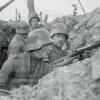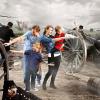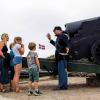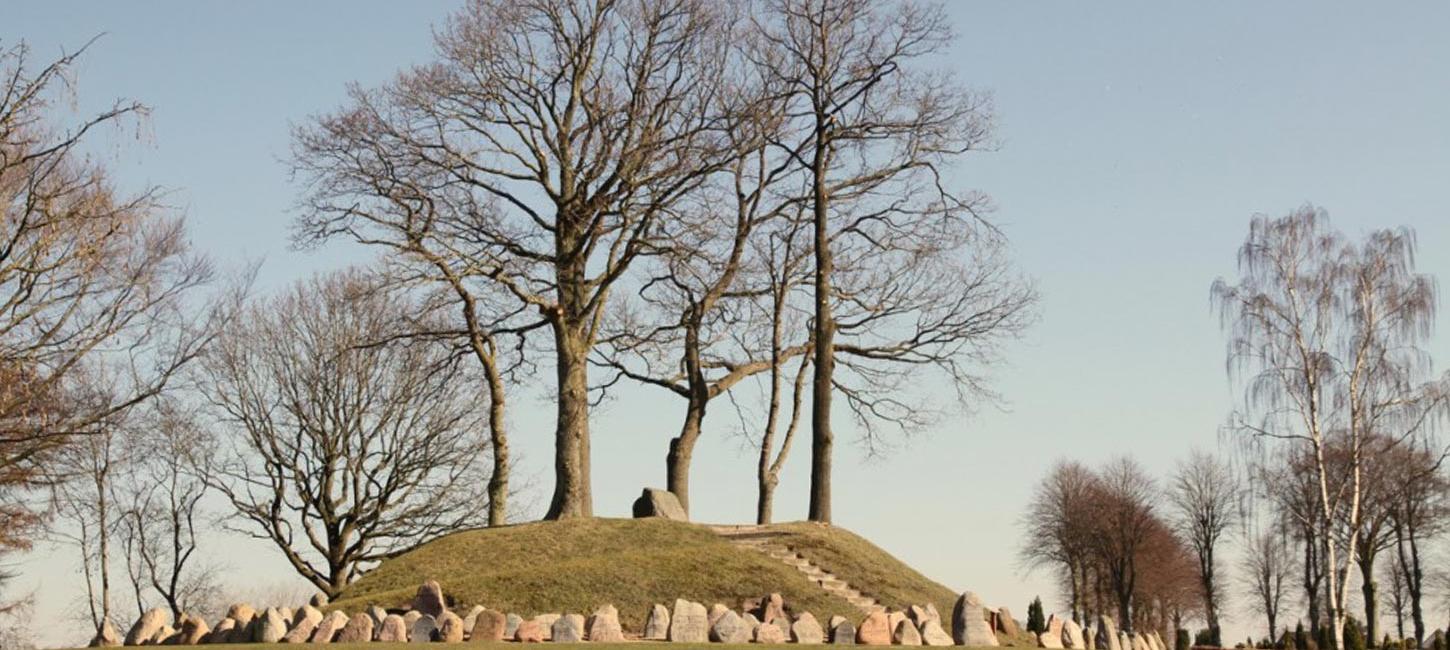
War graves and memorials – First World War
At the vast majority of churchyards in Sønderjylland you’ll find memorials and graves for citizens of Sønderjylland that lost their lives in the First World War. The majority of the memorials include both Danish-minded and German-minded soldiers.
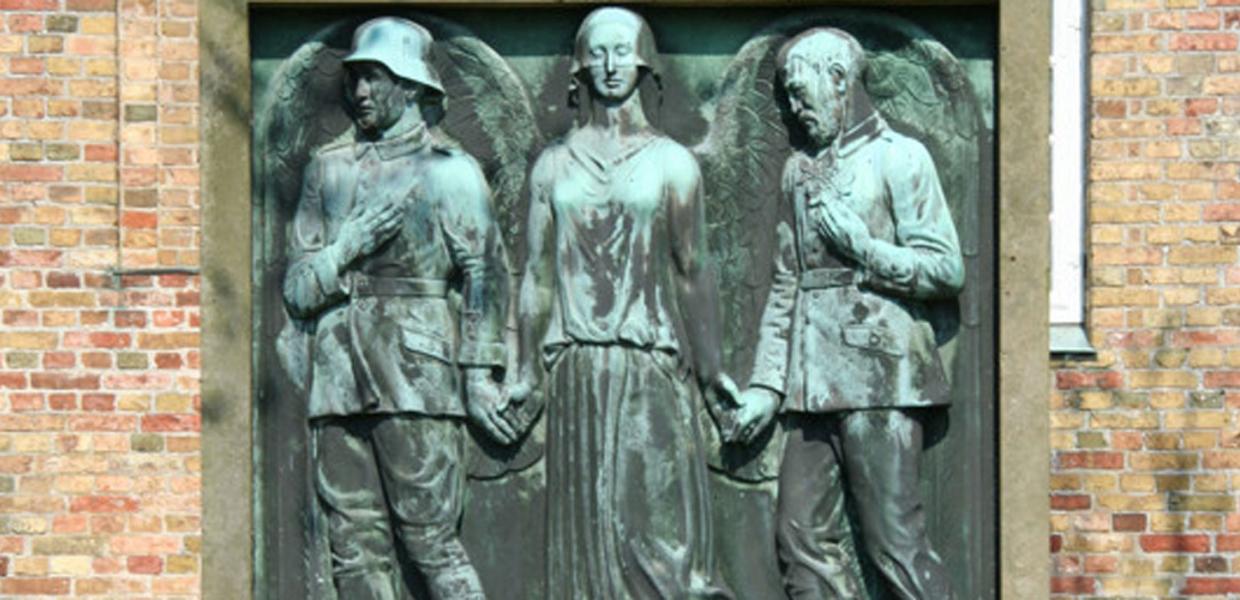
Photo:Verdenskrigensspor.dk
Memorials to the fallen
St. Nikolaj’s Church, Aabenraa
South of St. Nikolaj’s chancel is Aabenraa’s memorial to those who lost their lives in the First World War: a granite plinth with a bronze relief depicting the Angel of Death between two soldiers. The soldier on the left is wearing the German steel helmet and below him is written: “Unseren gefallenen Söhne”. The soldier on the right is bare-headed and bearded and below him is written: “In memory of our fallen”. Names of the fallen don’t appear on the monument, but on a number of panels in the church. The memorial was erected in an atmosphere of mutual German-Danish peace and understanding, and it was important that the competition to design the monument was open to both Danish and German artists. The competition was won by Danish sculptor Johannes Clausen Bjerg (1886-1955). The memorial was inaugurated on 18 November 1923. The inauguration began with a Danish service, after which the monument was unveiled by the bishop for the newly established Haderslev diocese. The church then hosted a German memorial service. There was also a memorial celebration at the People’s Home. The monument cost DKK 10,000, funds which were raised by means of a collection in Aabenraa.
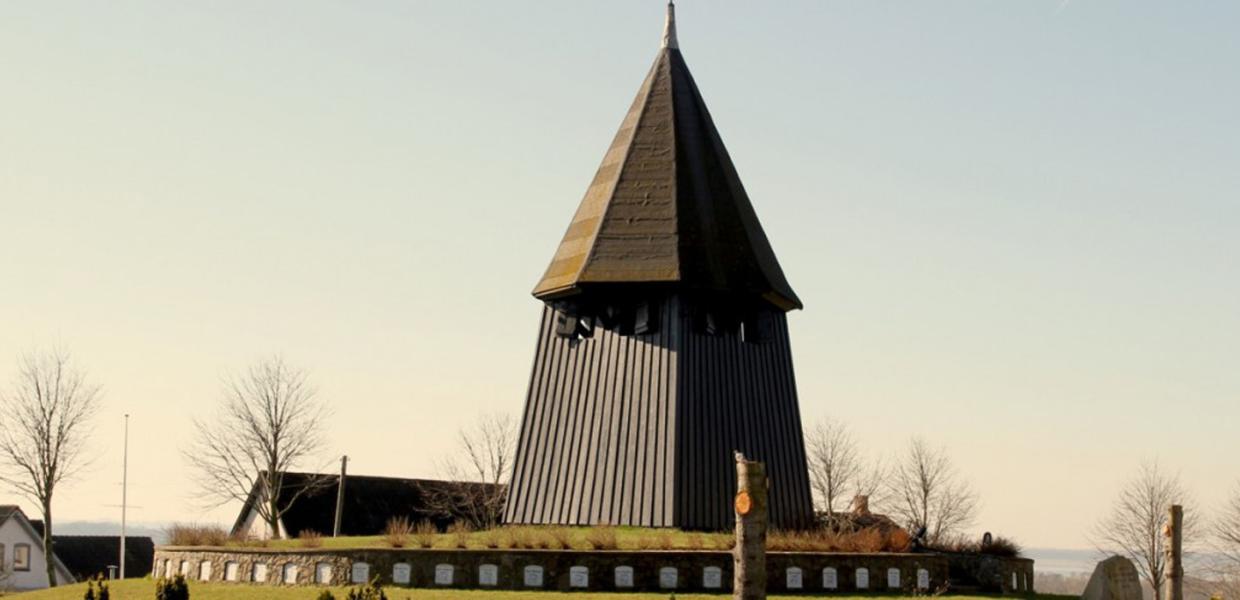
Photo:Verdenskrigensspor.dk
Egen Church, Als
At the churchyard west of the church, 66 marble slabs have been set in a low stone wall along the edge of a Bronze Age mound, on top of which is a medieval belfry. At the approach to the mound lies a stone with the inscription: “In memory of the sons of the Parish of Egen who fell in the 1914-1918 War”. Each of the slabs has the name of a member of the parish who lost their life. The memorial was based on an idea by architect Dahl from Flensburg, and was constructed by master builder Brix according to master builder Knudsen’s drawing. The marble slabs, which were bought in Kiel, cost around 10,000 marks, which were collected prior to Reunification. DKK 2,700 was subsequently raised to cover the other costs of establishment of the memorial.
Broager Church
The churchyard in Broager has a memorial mound, around the foot of which are two rows of 164 stones with the names of the fallen. The majority carry only a single name, although a number have more than one name in the event that several family members are inscribed on the same stone. Two stones have the names of four brothers, whilst another has a father and two sons. There are 188 names in all. The stones all originate from Broagerland and are grouped according to the home town of the fallen, which are marked along the edge of the mound with a stone for each of Broager’s nine villages. On the top of the mound is a boulder carrying the inscription: “Stone placed over the Sons of Broager Land in Memory of the Fallen in the 1914-18 War”. Nine oak trees were also planted, although not all of them have survived to this day. Artist Johan Thomas Skovgaard (1888-1977), who carved the memorial stones in Dybbøl and Varnæs, assisted in the planning of the memorial. It was inaugurated on 19 November 1922 at a memorial service in Broager Church.
Sønderborg
At the church square east of St. Mary’s Church there’s a four-metre-high plinth with the names of Sønderborg’s 102 fallen citizens. It’s crowned by a cenotaph – en empty tomb. The memorial was jointly erected by Danish and German citizens and it was decided not to have any inscriptions other than “1914-1918” on the cenotaph, as well as the names and year of the fallen soldiers on the plinth. Architect Thomas Havning (1891-1976) designed the memorial, and it was carved by sculptor Iversen from Sønderborg. The memorial was unveiled on 20 May 1923, with speeches being held in both Danish and German. The empty tomb is a classic motif – and therefore on the face of it seemingly neutral. The design, however, is very similar to the British monument for the nation’s fallen, which was erected in London shortly after the end of the war.
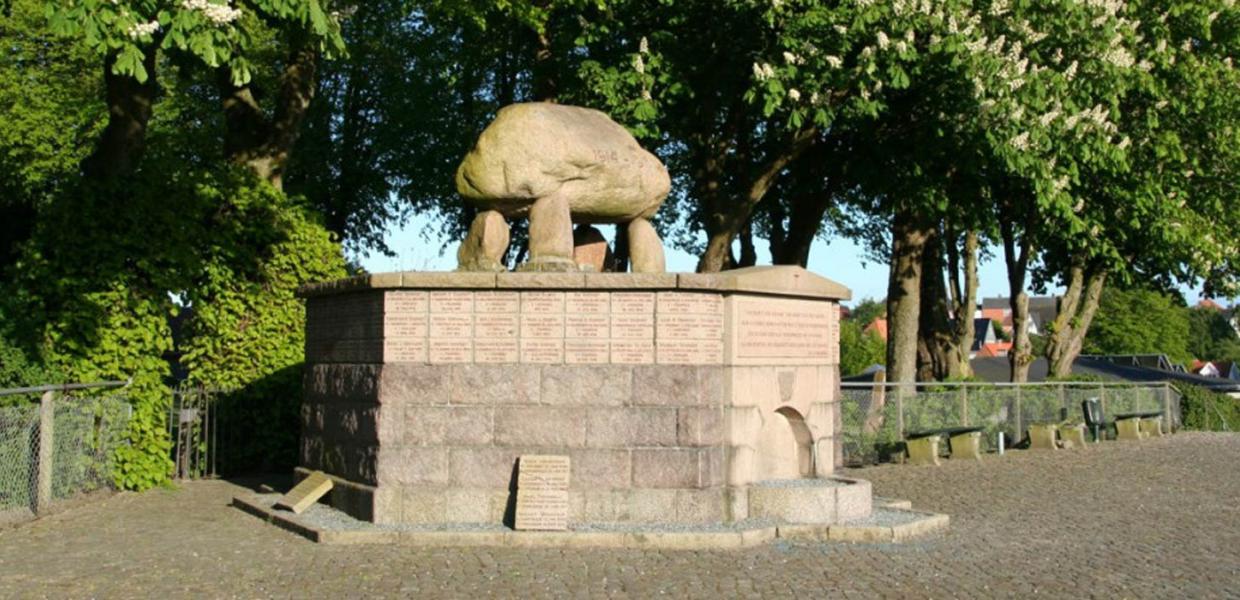
Photo:Verdenskrigensspor.dk
Monastery cemetery, Haderslev
At the former monastery cemetery, with its view of the lake of Haderslev Dam, there are two memorials for the fallen in the First World War: one Danish and one German. In 1922, agreement had actually been reached on a joint monument, but the removal and destruction of a memorial to the fallen citizens of Schleswig-Holstein 1848-51 resulted in an impasse. It proved impossible to agree on either the language or wording of the inscription. The German monument consists of a stele with the names of the fallen crowned with a German steel helmet on a laurel wreath and produced in Treuchtlingen Marble. It was produced by the Southern German sculptor Hermann Blecker, and was made possible by a donation from German welfare organisation Arbeiterwohlfahrtsverein. The memorial was unveiled on 18 January 1925, and both at the ceremony at the cemetery and the subsequent service, Danish-minded soldiers were also remembered. Originally 173 names were carved into the stone, but today there are 211 on the yellow-painted stone. The Danish memorial consists of a hexagonal granite plinth with a dolmen on top with the years 1914-1918 on the lintel. The names of the 112 fallen soldiers are written on stone tablets on the plinth and at its foot. The memorial was designed by architect Peter J. Gram and produced by sculptor A. Petersen, whilst the poem on the front is written by author and police officer Erich Erichsen. The national contrast is clearly reflected in the design of the two monuments: the dolmen being just as much an important element in Danish national romanticism as the steel helmet and laurel wreath are features of German military symbolism.
Gram
The memorial is located on a small square south of Gram churchyard, and consists of the bronze figure “Grief” standing on a granite plinth on which a poem and the names of the Parish of Gram’s 60 fallen soldiers are written. It was produced by sculptor Niels Hansen Jacobsen (1861-1941), who came from Vejen and who from 1914 had a studio in Skibelund Krat, a national meeting point just north of the Danish-German border at the time. He also wrote the poem on the plinth: “Grief, she wanders far and wide, in a thousand homes she has entered; now she returns to distant countries to find the graves and crosses of Danish men.” Of the 60 fallen soldiers, 23 came from Gramby, 21 from Kastrup, 9 from Tiset, 3 from Enderupskov and 4 from Vester Lindet. The great majority lost their lives on the Western Front – 46 in all. The bronze figure was presented in Gram somewhat earlier – in 1918 – but the memorial as a whole wasn’t unveiled and inaugurated until 6 June 1924.

Photo:Verdenskrigensspor.dk
In addition to memorials for local citizens, there are also war graves for prisoners of war and other prisoners.
Prisoners of war
The prisoners of war (POWs) were soldiers from Russia, France, Belgium and Great Britain who’d been captured by the German army and then sent to Southern Jutland (Northern Schleswig). The prisoners lived in wretched conditions, as a result of which many died early in the war. There are POW graves at the churchyards in Tinglev and Løgumkloster.
Other prisoners
Other prisoners were soldiers from the German army that had contravened army rules. Originally, these convicted prisoners were interned in German fortified prisons, but from autumn 1916 it was permitted to move them outside these strongholds. A number of them were therefore employed in the construction of Defence Line North, which ran south of the border to Denmark at the time, following the path of the stream of Kongeå. A total of 32 companies of 250 men were commanded to do the most laborious work on the defensive line. The prisoners worked from early in the morning until evening and often had to walk a long way to and from the defensive line. At the same time, the food was poor and there was strict discipline and heavy punishment; hence the burial sites at churchyards along the entire length of Defence Line North. The majority were buried at the churchyard in Løgumkloster. The graves were demolished during the Second World War and only a small proportion of the gravestones remain.
